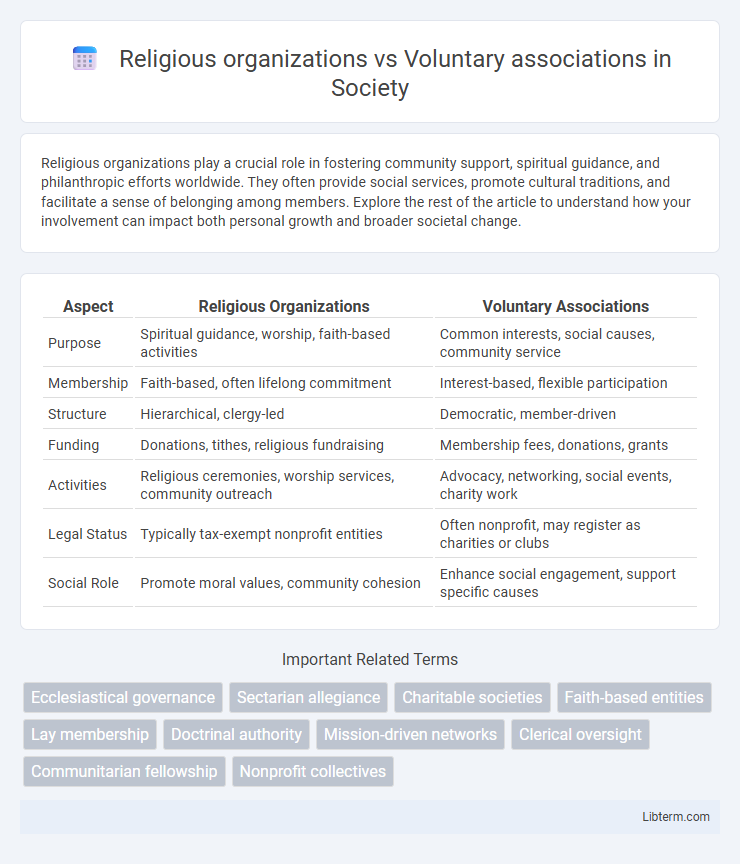Religious organizations play a crucial role in fostering community support, spiritual guidance, and philanthropic efforts worldwide. They often provide social services, promote cultural traditions, and facilitate a sense of belonging among members. Explore the rest of the article to understand how your involvement can impact both personal growth and broader societal change.
Table of Comparison
| Aspect | Religious Organizations | Voluntary Associations |
|---|---|---|
| Purpose | Spiritual guidance, worship, faith-based activities | Common interests, social causes, community service |
| Membership | Faith-based, often lifelong commitment | Interest-based, flexible participation |
| Structure | Hierarchical, clergy-led | Democratic, member-driven |
| Funding | Donations, tithes, religious fundraising | Membership fees, donations, grants |
| Activities | Religious ceremonies, worship services, community outreach | Advocacy, networking, social events, charity work |
| Legal Status | Typically tax-exempt nonprofit entities | Often nonprofit, may register as charities or clubs |
| Social Role | Promote moral values, community cohesion | Enhance social engagement, support specific causes |
Defining Religious Organizations and Voluntary Associations
Religious organizations are structured groups centered around shared faith, worship practices, and spiritual beliefs, often established as non-profit entities with formal governance. Voluntary associations consist of individuals united by common interests or goals, functioning through members' voluntary participation without necessarily having religious affiliations. Both types of organizations rely on collective cooperation but differ fundamentally in purpose, with religious organizations focused on faith-based activities and voluntary associations emphasizing social, cultural, or recreational objectives.
Historical Evolution of Religious Organizations
Religious organizations have historically evolved from ancient tribal cults to complex institutionalized systems influencing social, political, and cultural structures worldwide. Their development often parallels the codification of sacred texts, establishment of clerical hierarchies, and the expansion of missionary activities, distinguishing them from voluntary associations primarily focused on secular social or philanthropic goals. Key milestones include the rise of major world religions such as Christianity, Islam, Buddhism, and Hinduism, which shaped global civilizations through organized worship, doctrinal authority, and community rituals.
Origins and Development of Voluntary Associations
Voluntary associations originated as collective groups formed by individuals to pursue common interests or social causes, distinct from religious organizations established primarily for worship and spiritual guidance. These associations evolved through grassroots movements and civic engagement, emphasizing democratic participation and service to community needs beyond religious frameworks. Unlike religious institutions with hierarchical structures, voluntary associations often embrace flexible governance to adapt to diverse secular objectives and social reform efforts.
Core Purposes and Objectives
Religious organizations primarily focus on promoting spiritual beliefs, worship practices, and religious teachings to foster faith communities and moral values. Voluntary associations concentrate on serving social, cultural, educational, or political objectives through collective action and member participation. Both aim to strengthen community bonds but differ fundamentally in their core purposes: one centers on faith and spirituality, the other on civic engagement and mutual interests.
Membership Structures and Entry Criteria
Religious organizations typically require adherence to specific faith-based beliefs and practices as core entry criteria, often involving rituals such as baptism, confession, or formal declarations of faith, which shape membership structures around shared doctrines and communal worship. Voluntary associations, in contrast, emphasize voluntary participation without doctrinal requirements, allowing open membership based on common interests, goals, or activities, fostering inclusive and flexible structures that promote diverse involvement. Membership in religious organizations tends to be more hierarchical and regulated, while voluntary associations maintain adaptable frameworks focused on individual commitment and collective objectives.
Governance and Leadership Models
Religious organizations typically feature hierarchical governance structures with centralized leadership, often guided by theological principles and clerical authority, which ensures doctrinal consistency and control over community practices. Voluntary associations, in contrast, employ more democratic or participatory leadership models, emphasizing member involvement and consensus-based decision-making to address diverse interests and foster collective action. These differing governance frameworks impact organizational accountability, decision speed, and the alignment of leadership with member values.
Rituals, Practices, and Activities
Religious organizations center their rituals, practices, and activities on worship, sacraments, and ceremonies that often follow sacred texts and doctrines, fostering spiritual experiences and community cohesion. Voluntary associations engage in a diverse range of activities based on shared interests or goals, including social events, advocacy, or hobby-related projects, without the spiritual or ritualistic framework seen in religious groups. The formalized rituals in religious organizations typically serve to reinforce faith and identity, whereas voluntary associations emphasize practical collaboration and social interaction.
Social Influence and Community Roles
Religious organizations exert significant social influence through shared beliefs, rituals, and moral guidance, fostering community cohesion and identity. Voluntary associations contribute to social capital by promoting civic engagement, providing mutual support, and addressing local needs through collective action. Both entities play crucial roles in community development, yet religious organizations often integrate spiritual dimensions, while voluntary associations emphasize secular collaboration and diverse membership.
Legal Status and Regulatory Frameworks
Religious organizations often benefit from tax-exempt status under laws such as the Internal Revenue Code Section 501(c)(3) in the United States, which recognizes their spiritual mission and grants them specific regulatory exemptions. Voluntary associations, while also capable of obtaining nonprofit status, are generally subject to more stringent reporting requirements and regulatory oversight due to their broader, non-religious purposes. The legal framework for religious groups prioritizes protection of religious freedom and autonomy, whereas voluntary associations must comply with standard nonprofit governance rules, including transparency and financial accountability.
Contemporary Challenges and Future Trends
Religious organizations face contemporary challenges including declining membership, increasing secularization, and navigating legal restrictions on religious expression. Voluntary associations encounter trends such as digital transformation, volunteer engagement decline, and shifting donor patterns influenced by economic uncertainty. Both entities are likely to adopt hybrid models leveraging technology for community building and resource mobilization to remain resilient and relevant in the future.
Religious organizations Infographic

 libterm.com
libterm.com